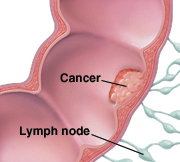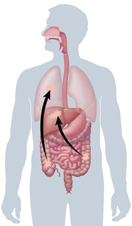Staging Colorectal Cancer
Staging Colorectal Cancer
Colorectal cancer can grow outside of the colon or rectum. In time, it can grow into nearby organs or spread to nearby lymph nodes (immune system tissues) and then travel to other parts of the body. Cancer cells can also get into the blood to travel to other parts of the body. This is known as metastasis. Doctors stage cancer to tell whether it has spread, and if so, how far. Staging may be done before or after surgery. Knowing the cancer stage helps the healthcare provider make the best treatment plan.
Colorectal cancer has four main stages, based on where the tumor is. Usually, it starts in the inside lining and then moves deeper into the colon wall. If cancer is found early, when it's only in the inside lining, it may be called stage 0 or carcinoma in situ.
Stage I: Cancer has spread into the muscle wall of the colon or rectum. |
Stage II: Cancer has spread to the outer wall of the colon or rectum. It may have spread outside to nearby organs or tissues, but not to lymph nodes or distant parts of the body. |
Stage III: Cancer may or may not have spread through the wall of the colon or rectum. It has spread to nearby lymph nodes or the fat around them and to nearby tissues or organs. It has not spread to other parts of the body. |
Stage IV: Cancer cells have spread to distant parts of the lining of the abdomen (called the peritoneum), distant lymph nodes, or organs such as the lungs and liver. |
Updated:
April 06, 2018
Sources:
Colorectal cancer TNM staging AJCC UICC 2017. UpToDate.
Reviewed By:
Alteri, Rick, MD,Levy, Adam S, MD



